Top News
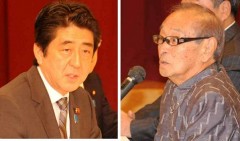
February 3, 2013 Ryukyu Shimpo
On February 2, for the first time since regaining the premiership, Prime Minister Shinzo Abe visited Okinawa to meet Okinawa Governor Hirokazu Nakaima at a hotel in Naha. While Nakaima expressed his gratitude to Abe for meeting Okinawan requests for about 300 billion yen in development funding for the prefecture in its draft fiscal 2013 budget, he again requested that the central government relocate Futenma Air Station outside of the prefecture. Abe reiterated that the central government intends to adhere to its plan to move the facilities to the Henoko area of Nago as agreed with the U.S. government. The prime minister talked to the press after the meeting with Nakaima, saying, “We are not thinking about lodging the application for the land reclamation in the Henoko coastal area before my trip to Washington later this month.” Members of the media were allowed to attend the first part of the meeting, but Abe and Nakaima then moved to a separate room where they continued their discussions for about 30 minutes by themselves.
Nakaima requested that Abe rescind the deployment of the MV-22 Osprey transport aircraft now deployed at Futenma Air Station, saying, “The Okinawan people are really concerned about the safety of this aircraft.” Abe responded saying, “We will definitely ensure the safety of the Okinawan people. The central government is doing its best to dispel residents’ concerns over safety issues, and is trying to arrange for training in the aircraft to be held outside of Okinawa to the greatest extent possible.” With regard to the return of six other U.S. military facilities located south of Kadena Air Base, Abe said, “We will work to speed up the creation of an integrated plan.”
Abe suggested that the former administration led by the Democratic Party of Japan (DPJ) worsened the relationship between the central government and Okinawa. He said, “Over the past three years, the DPJ failed to build a trusting relationship with Okinawa. First of all we want to work to regain the trust of the people of Okinawa.”
Abe stated that the central government will allocate budget to build a second runway at Naha Airport, and will reduce the period required for construction. He said, “We have managed to secure budget for the project. It is regarded as an investment in the future, and is expected to have a large and positive economic impact. It will be a feature of the economic policy of my administration.” With regard to the Okinawa Institute of Science and Technology Graduate University (OIST), Abe said that he will promote the school as part of national policy, saying, “OIST is one of our strategies to boost the nation’s growth.”
In addition to the meeting with Nakaima, Abe visited the Japan Air Self-Defense Force Naha Air Base and OIST. After looking over Futenma Air Station from the Kakazu observation deck, he flew back to Tokyo that night.
(English translation by T&CT, Mark Ealey)
Go to Japanese
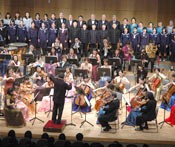
January 22, 2013 Takahiro Miyagi of the Ryukyu Shimpo
On January 20, at the Nanjo City Culture Center Sugar Hall, the professional orchestra group known as the Sugar Hall Orchestra held its first concert, entitled, Fate. Together with previous prizewinners of the Okiden Sugar Hall Armature Audition and professional musicians from both inside and outside of Okinawa, the orchestra performed a program of music that local children helped to create.
Nineteen years have passed since the hall opened as the first music center in Okinawa and this concert represents a new start with the current young generation.
This event was held as a part of a project to enable junior high school students to experience performing with an orchestra. The children took part in a workshop on Beethoven’s Symphony No. 5 Fate and also experienced an open rehearsal. On the day, the performers played and introduced each instrument to the audience and the children joined in singing.
The concert began with Mozart’s opera The Marriage of Figaro. The audience enjoyed the passionate rhythm of the opening line of Fate, and its rolling melodies were particularly dramatic. The conductor used lithe movements to draw out the unique sound of each instrument, producing a beautiful world of sound with the combined harmonious melodies.
In the second half of the program the orchestra played pop songs that had been requested by junior high school students. Ai-uta by GReeeeN is a love song with a sentimental melody.
Monster Hunter was delivered with a passionate performance full of energy.
Ryuichi Sugimoto’s BELIEVE was performed with students of Sashiki Junior High School and the Sugar Hall Junior Chorus. The concert was brought to an end after expressing hope for the future.
(English translation by T&CT, Megumi Chibana and Mark Ealey)
Go to Japanese
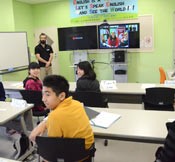
January 27, 2013 Ryukyu Shimpo
Since last year, in conjunction with Washington State University, the Kitanakagusuku Municipal Office has been using a video-conference system to run a distance e-learning English program for elementary and junior high school pupils. The program is planned and operated by the NPO Incorporated Ryukyu America Historical Research Society. According to the society, this is the first ESL (English as a Second Language) program provided by the Washington State University in Japan. The municipal office wants to develop human resources within the village.
Currently ten elementary and junior high school pupils receive tuition in the program twice a week at the Ayakari-no-Mori facility in Kitanakagusuku. Two monitors are used, one showing the instructor and his or her assistant, and the other showing the lesson notes and other related materials to the class. A microphone relays the pupils’ voices in the classroom to the instructor at Washington State University.
Kitanakagusuku, the society and Washington State University concluded the agreement in April 2012, and the municipal office is using a grant from the central government to fund the program.
On January 16, Kitanakagusuku Mayor Kunio Arakaki visited the classroom and said, “Human resources are valuable for the village. We want to develop world-class human resources and to expand this program to include staff members in the municipal office and other people.” On the same day, Nanjo City Mayor Keishun Koja visited the program, and the Higashi Village Municipal Office is also interested in the e-learning English program.
(English translation by T&CT, Hitomi Shinzato and Mark Ealey)
Go to Japanese
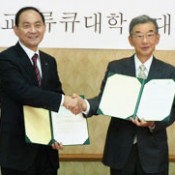
February 1, 2013 Ryukyu Shimpo
On January 24, the Mokpo National University of Korea and the University of the Ryukyus concluded academic exchange and cooperation agreements at the University of the Ryukyus campus in Nishihara. These agreements encourage both universities to exchange researchers and students, as well as to carry out joint research projects.
The two universities have interacted in the past. On August 31, 2011, an exchange program started between the Mokpo National University Institute for Marine and Island Cultures and the International Institute for Okinawan Studies at the University of the Ryukyus. They will seek to promote cooperation for further academic research.
After the signing of the agreements, Teruo Iwamasa, the president of the University of the Ryukyus, commented, “We are looking forward to seeing more exchange between Okinawa and Korea.” Seok-Kyu Ko, the president of Mokpo National University, said, “We want to make this opportunity worthwhile for both parties through active exchange between students and researchers.”
(English translation by T&CT, Kyoko Tadaoka and Mark Ealey)
Go to Japanese
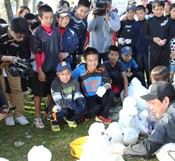
February 3, 2013 Ryukyu Shimpo
On February 2, about 40 children enjoyed using snow transported from Hokkaido to make snowmen at the Nago Municipal Stadium. This is the venue of the professional baseball team Hokkaido Nippon-Ham Fighters’ training camp. Four companies, including Hokkaido Shimbun Press and All Nippon Airways, supported this project. They transported two tons of snow to Nago from the baseball ground at Kurinoki Farm, which is owned by Nippon-Ham Fighters’ manager Hideki Kuriyama.
Kuriyama visited the stadium and wished the children well, saying, “Good luck with your studies and with your play!”
It was cold for them to touch, but Hiroya Gushiken and Daichi Naganohara, both in the sixth grade at Omiya Elementary School and the members of baseball team Miyazato Braves, cried out with joy on seeing snow for the first time.
On February 1, Masatoshi Murata, the chairman of the Association to Support Nippon Ham Hokkaido and the president of the Hokkaido Shimbun, visited the Ryukyu Shimpo Office in Naha. He explained the project, saying, “By touching snow, we want Okinawan children to develop an interest in Hokkaido, and to support the Nippon Ham team.”
(English translation by T&CT, Mark Ealey)
Go to Japanese
February 1, 2013 Hideki Matsudo of the Ryukyu Shimpo reports from Washington D.C.
On December 30, in a written statement submitted to a hearing of the Senate Arms Services Committee, Chuck Hagel, the former Republican senator who has been nominated to become defense secretary in the second Obama administration, pledged to work with the Japanese government to address Okinawa’s concerns about U.S. forces. Hagel indicated that he intends to strive to ease the burden on Okinawa of hosting the U.S. bases. This is the first time that he has referred to Okinawa since being appointed as secretary of defense. Relatively close to President Obama in terms of his political standpoint, Hagel is known as having been a moderate Republican senator who was opposed to the Iraq War and advocates nuclear disarmament. While the U.S. government has made no change to its stated policy of relocating the United States Marine Corps Air Station Futenma to Henoko in Nago, Hagel has referred to the need for a politically sustainable stance for U.S. military readiness. His leadership as the head of the Department of Defense is likely to be tested when it comes to walking the talk on reducing the burden on Okinawa.
With regard to the new defense strategy that reorients the U.S. military toward the Asia-Pacific region, Hagel stated that, “A robust U.S. military presence in the Asia-Pacific has underwritten peace and prosperity in the region for the past 60 years. The Department should be able to assure regional allies and partners, deter threats to regional stability, and prevail in conflicts if necessary,” and that ” I would support the administration’s effort to work towards a posture that is more geographically distributed—for example, the movement of forces to Guam and Australia.” He also stated that the U.S. military presence must be politically sustainable and that the United States must work with its partners and allies to address their concerns about that presence, such as in Okinawa.
(English translation by T&CT, Mark Ealey)
Go to Japanese

February 1, 2012 Ryukyu Shimpo
A total of 12 professional baseball teams commenced training camps on February 1. Eight of them have come to Okinawa to hold camps in various parts of the prefecture. On January 31, three teams, the Hokkaido Nippon-Ham Fighters, the Yokohama DeNA BayStars and the Tohoku Rakuten Golden Eagles arrived in Okinawa in quick succession.
When the players and people involved with the Hokkaido Nippon-Ham Fighters arrived at Naha Airport, more than 200 people, including tourists, baseball fans, and members of the media crowded into the arrival lobby to see Shohei Otani. The young star graduated from Hanamaki Higashi High School in Iwate prefecture and joined the Hokkaido Nippon-Ham Fighters as their first draft pick. The team attracted a great deal of attention, with the crowd whistling as the team members, including manager Hideki Kuriyama came out. Fans gave the team a good welcome, calling out “Mensore” (welcome) to them.
Seventy two year-old Naha resident Minoru Kikuchi, who belongs to the Chura Menkoi Kai, the Iwate Association of Okinawa, welcomed Otani with a handmade banner saying, “Welcome, the Hokkaido Nippon-Ham Fighters pitcher Otani.” Kikuchi said, “Otani is a rising star from Iwate. I want him to do his best within the team and to lift the spirits of and give hope to people in quake-stricken areas by playing baseball. The members of our association will go to Kunigami and cheer for Otani.”
Go to Japanese

Go To Video
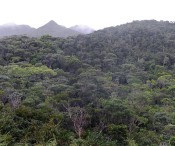
February 1, 2013 Ryukyu Shimpo
On January 31, at a meeting of the Inter-Ministerial/Agency Co-ordination Committee for World Natural Heritage held at the Foreign Ministry, the Japanese government decided to apply for the inclusion of the Amami and Ryukyu islands on UNESCO’s provisional list of candidates for World Heritage sites. Islands in Kagoshima and Okinawa prefectures were selected as candidates for World Heritage sites in 2003. The inclusion on the list is part of the process for officially recommending the islands to become World Heritage sites. The Environment Ministry is keen to secure World Heritage status for the islands, and if they are registered by the U.N. Educational, Scientific and Cultural Organization as World Natural Heritage sites, it will be Japan’s fifth listing. This is the first time in six years that sites in Japan have been included on UNESCO’s provisional list, the last being the Ogasawara Islands, which were registered as World Natural Heritage sites in June 2011.
There are still two major screening processes before sites are officially registered, but Okinawan people’s dream of registration of the islands has now made major progress ten years after the islands were selected as candidates.
The government will submit the list to the UNESCO World Heritage Centre in the near future, and is prepared to submit the necessary documents, including those designating the recommended areas.
Submission of the documents for recommendation is expected to take some time because land has to be converted into national parks, and the protected areas have to be designated and expanded. These steps are prerequisites in the process for recommendation.
Reiji Kamesawa, the head of the Biodiversity Policy Division of the Nature Conservation Bureau of the Ministry of the Environment talked to the press after the committee meeting, saying, “Full registration will take three years at the earliest.” It took three years for the recommendation documents for the Ogasawara Islands to be submitted after their inclusion on the list in January 2007, and four years for full registration to be completed.
The Amami-Ryukyu region is inhabited by relict species, that is, species that are thought to have been more widespread in the past than now. Such species have a discontinuous breeding distribution, usually because of climatic change. They have evolved in their own way in the process of the continuous separation and merging of the islands. The government rates the islands highly because rare species included in the International Union for Conservation of Nature Red List of Threatened Species inhabit the islands, and it is important to preserve the biodiversity there.
Go to Japanese
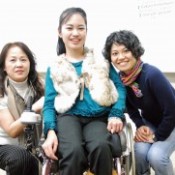
January 26, 2013 Ryukyu Shimpo
Twenty five year-old Miki Higa, who was born with cerebral palsy, will visit the Philippines for a week from February 28 as the first person to go on the FLY ANAY! PROJECT. This project was established to support physically challenged individuals whose dreams are to travel abroad. The program includes a home-stay as well as exchanges with local people with disabilities. Higa is looking forward to making her first overseas trip.
Higa dreams of making friends all across the globe. She studied English at university, but was often frustrated by being asked why she did not study welfare instead because of her condition.
After graduation, Higa struggled to find a job in which she could make use of her language skills. That was when Natsuki Soda, the field coordinator of the FLY ANAY! PROJECT, came along to give Higa a supportive push. Soda also has a physical disability, and in the past she had lost hope about her future. However, her dream of working in the developing world came true because of support from her friends and family. Soda believes that there are many things that physically challenged people can achieve if there is support from society. Soda invited Higa to participate in this project.
In keeping with Higa’s request, a Japanese supporter and a local helper will accompany her during the program. All the communication will be carried out in English. Higa commented, “I would like to try to see to what extent the things I say will be understood. There are many individuals with physical disabilities who would love to go travel abroad. I hope that this opportunity for me serves as an inspiration to others, giving them hope to commit themselves to future challenges.” In the Tagalog language the expression “fly anay” means “let’s fly first.” The project aims to support physically challenged individuals aged between 18 to 25 year-old who would like to travel overseas. It was established in June of last year thanks to the joint efforts of the NPO Lequio Wings (formed by alumni of the Japan International Cooperation Agency) and the Association of Disabled Persons-Iloilo, Inc. in the Philippines. They are currently asking for donations to cover the cost of travel for the accompanying supporters and payment for such assistance.
(English translation by T&CT, Kyoko Tadaoka and Mark Ealey)
Go to Japanese

January 24, 2013 Ryukyu Shimpo
Twenty one year-old student Seira Kawabata, who was chosen at the regional pageant held in Yomitan last November to represent Okinawa at the Miss Universe Japan 2013 pageant, visited the Ryukyu Shimpo Office recently. The Urasoe-born beauty queen said, “I want to convey to the world the charm of the natural beauty and the warm-hearted people of Okinawa.” She is determined to win the Miss Universe Japan pageant, and aims to become Miss Universe. The Japan pageant will be held at the Tokyo International Forum on March 4.
Kawabata is 173 centimeters tall, has distinct facial features, and is fluent in English. She left Okinawa at the age of 14 to study in the United States, and is currently enrolled in a course in economics at Boston University. She says that during her years spent in the United States her heart has always been in her homeland of Okinawa. The prefectural tournament was her first experience to go up on stage as a model. When she was selected to represent the prefecture she said, “The first thing I felt was relief to hear the result. There was also some pressure on me because I did not want to disappoint the many people who have supported me.” She added, “When my family and friends congratulated me, I felt that so much love was coming my way.” Grateful to her homeland, her next goal is to win the Miss Universe Japan pageant. She is now training hard in Tokyo to prepare herself mentally and physically. She said, “First of all, it is important to prepare myself properly in order to convey the charm of the natural beauty and the warm people of Okinawa to the rest of the world. I will be better tomorrow than today, and better the day after that. I have to work hard from now so I can grow little by little every day, as I approach the challenge ahead of me in a positive frame of mind,” she said in a determined manner.
(English translation by T&CT, Mark Ealey)
Go to Japanese
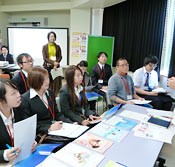
January 23, 2013, Ryukyu Shimpo
On January 18, the International Student Center of the University of the Ryukyus held a special Career Fair for foreign students. According to the center, this is the first of its kind to be held in Okinawa. A total of 39 participants from four universities and two two-year colleges attended. The organizers commented that they were surprised with this unexpectedly high turnout and said that it illustrates the great interest among international students in finding employment in Okinawa.
Five companies from the food, catering and hospitality industries set up booths and gave presentations to the participants. Important issues such as working visa applications, cultural differences and the language barrier in the workplace were explained during the session.
Comparing the employment situation for foreign students in recent years, Yurie Jiroku, a career consultant at the center, said that companies have been reluctant to hire foreign students in the past, but that, “The situation has changed in the last few years. Businesses now want to hire people from overseas.” This is due to the recent increase in foreign tourists as well as business expansion into foreign markets.
Tomoyuki Nakamura, the manager of the personnel and administration division of Okinawa Watabe Wedding said, “International students know about places other than their own. They have the courage to take on new challenges and are also open-minded.”
Lina, a Chinese student who studies at Okinawa Women’s Junior College commented, “Because I’m learning Japanese, I would like to work in Japan. I’m interested in places like hotels and tourist businesses where I can make use of my language ability.”
(English translation by T&CT, Kyoko Tadaoka and Mark Ealey)
Go to Japanese











 Webcam(Kokusai Street)
Webcam(Kokusai Street)


